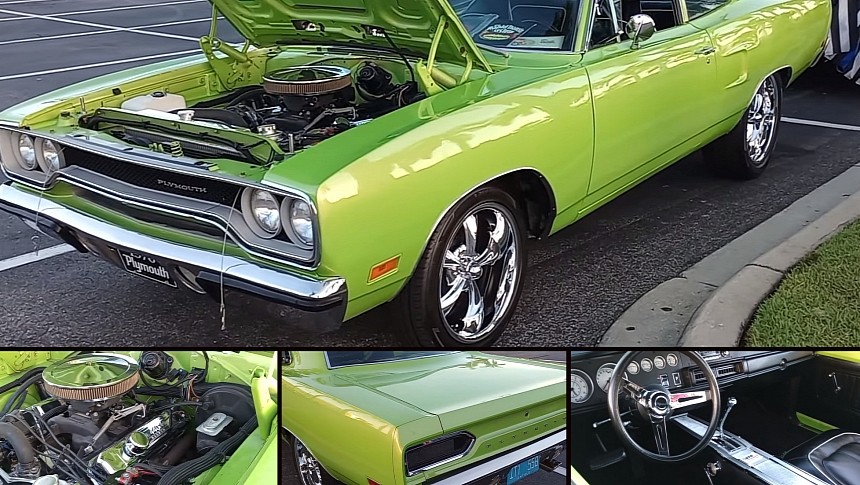Built from 1954 to 1970, the Belvedere is one of Plymouth's most iconic nameplates. However, the midsize version that Chrysler began offering in 1962 doesn't get as much love as other muscle cars from the golden era. That's because the Belvedere was overshadowed by other Mopars based on the same B-body platform. I'm talking about the Road Runner, GTX, and Satellite.
Launched in 1964 as a model restricted to two-door body styles, the Satellite remained the range-topping version of the Belvedere until 1967. The GTX arrived in 1966 as a high-performance car with upscale trim. Finally, the Road Runner debuted as an entry-level performance version for the 1968 model year. All three were available with Mopar's most potent big-block engines, the 440-cubic-inch (7.2-liter) RB and the 426-cubic-inch (7.0-liter) HEMI.
Unlike its siblings, the Belvedere was available in four-door sedan and station wagon body styles, while the engine lineup included smaller mills. In short, its purpose wasn't to be fast but to sell in high numbers. And it did. The Belvedere moved more than 100,000 units per year from 1965 to 1967. In 1968, however, Belvedere sales dropped below the Road Runner, a trend that continued through 1970, when Plymouth discontinued the nameplate.
With 24,246 units delivered, the 1970 version is the rarest Belvedere out there. Sure, it's not as scarce as the GTX, which moved only 7,748 examples the same year, but the survivability rate of the Belvedere is much lower. With most of them already rusty and dismantled for parts, 1970 Belvederes in excellent condition are hard to come by, especially in two-door coupe trim.
Fortunately, some of them are still out there enjoying life as restored gems. This pillared coupe in Limelight Green is a gorgeous example. It's not entirely factory stock, but the upgrades are decidedly tasteful and put it into restomod territory without ruining its vintage appeal.
Fitted with blacked-out taillights, the Belvedere runs on modern five-spoke wheels wrapped in low-profile tires. Inside, the owner opted to enhance the instrument panel with white-faced gauges. He also replaced the woodgrain inserts on the center console with metal. Everything else appears to be factory correct, making this mild restomod more accurate than some restorations I've seen.
But things become much more interesting under the hood, where this Belvedere hides a 440-cubic-inch V8. It's an unexpected surprise, given that the big RB wasn't available in the Belvedere that year. The mill was restricted to the performance-oriented GTX and Road Runner models. The 383-cubic-inch (6.3-liter) V8 was the only big-block lump offered in the Belvedere in 1970, slotting above the 318-cubic-inch (5.2-liter) V8 and the 225-cubic-inch (3.7-liter) inline-six.
There's no info on what engine this coupe got from the factory (and we can't see the VIN), but it's a significant upgrade nonetheless. While the 383 V8 generated 335 horsepower, the four-barrel 440 RB had 375 horses on tap. This Magnum could also feature upgraded internals, so it might develop more than 400 horsepower. It's a sleeper and definitely cooler than the average 1970 Belvedere. Check it out in the video below.
Unlike its siblings, the Belvedere was available in four-door sedan and station wagon body styles, while the engine lineup included smaller mills. In short, its purpose wasn't to be fast but to sell in high numbers. And it did. The Belvedere moved more than 100,000 units per year from 1965 to 1967. In 1968, however, Belvedere sales dropped below the Road Runner, a trend that continued through 1970, when Plymouth discontinued the nameplate.
With 24,246 units delivered, the 1970 version is the rarest Belvedere out there. Sure, it's not as scarce as the GTX, which moved only 7,748 examples the same year, but the survivability rate of the Belvedere is much lower. With most of them already rusty and dismantled for parts, 1970 Belvederes in excellent condition are hard to come by, especially in two-door coupe trim.
Fortunately, some of them are still out there enjoying life as restored gems. This pillared coupe in Limelight Green is a gorgeous example. It's not entirely factory stock, but the upgrades are decidedly tasteful and put it into restomod territory without ruining its vintage appeal.
Fitted with blacked-out taillights, the Belvedere runs on modern five-spoke wheels wrapped in low-profile tires. Inside, the owner opted to enhance the instrument panel with white-faced gauges. He also replaced the woodgrain inserts on the center console with metal. Everything else appears to be factory correct, making this mild restomod more accurate than some restorations I've seen.
But things become much more interesting under the hood, where this Belvedere hides a 440-cubic-inch V8. It's an unexpected surprise, given that the big RB wasn't available in the Belvedere that year. The mill was restricted to the performance-oriented GTX and Road Runner models. The 383-cubic-inch (6.3-liter) V8 was the only big-block lump offered in the Belvedere in 1970, slotting above the 318-cubic-inch (5.2-liter) V8 and the 225-cubic-inch (3.7-liter) inline-six.
There's no info on what engine this coupe got from the factory (and we can't see the VIN), but it's a significant upgrade nonetheless. While the 383 V8 generated 335 horsepower, the four-barrel 440 RB had 375 horses on tap. This Magnum could also feature upgraded internals, so it might develop more than 400 horsepower. It's a sleeper and definitely cooler than the average 1970 Belvedere. Check it out in the video below.









